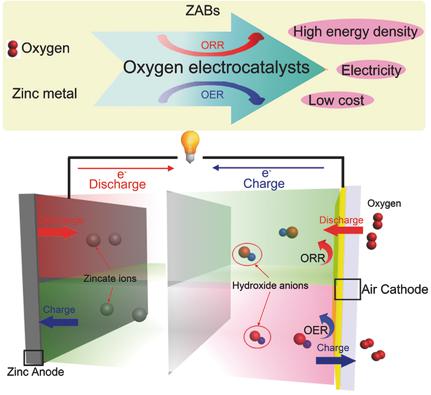当前位置:
X-MOL 学术
›
Small Methods
›
论文详情
Our official English website, www.x-mol.net, welcomes your
feedback! (Note: you will need to create a separate account there.)
Recent Progress in Oxygen Electrocatalysts for Zinc–Air Batteries
Small Methods ( IF 10.7 ) Pub Date : 2017-11-17 , DOI: 10.1002/smtd.201700209 Dongjiang Yang 1, 2 , Lijie Zhang 1 , Xuecheng Yan 2 , Xiangdong Yao 2
Small Methods ( IF 10.7 ) Pub Date : 2017-11-17 , DOI: 10.1002/smtd.201700209 Dongjiang Yang 1, 2 , Lijie Zhang 1 , Xuecheng Yan 2 , Xiangdong Yao 2
Affiliation

|
Zinc–air batteries (ZABs) have attracted extensive attention due to their remarkable high theoretical energy output. They represent one of the most promising future power sources. However, many barriers restrict their application on a large scale. One of the main challenges is the sluggish rates of the oxygen‐reduction reaction (ORR) and oxygen‐evolution reaction (OER), which govern the discharging and charging processes of the battery, respectively. Here, recent advances related to oxygen electrocatalyst materials for ZABs are discussed. Detailed discussions will focus on unifunctional ORR electrocatalysts and bifunctional ORR and OER electrocatalysts. Pt‐based nanomaterials, as the best ORR electrocatalysts, possess the virtue of high activity, but have the disadvantages of high cost, scarcity, and poor stability. Thus, materials based on transition metals (alloys, metal oxides, metal nitrides, and spinel oxides) and metal‐free materials are widely investigated as nonprecious ORR catalysts owing to their promising catalytic activities. As for bifunctional ORR and OER electrocatalysts, the following two categories are introduced: (i) metal‐based materials, including single metal/metal‐oxides‐based materials and mixed‐metal/metal‐oxides‐based materials; and (ii) metal‐free materials. Finally, perspectives on the continuous research and limitation of the current ZAB technology are provided.
中文翻译:

锌空气电池氧气电催化剂的最新进展
锌空气电池(ZAB)由于其卓越的高理论能量输出而备受关注。它们代表了未来最有前途的电源之一。但是,许多障碍限制了它们的大规模应用。主要挑战之一是氧气还原反应(ORR)和氧气释放反应(OER)的速度缓慢,它们分别控制电池的放电和充电过程。这里,讨论了与用于ZAB的氧电催化剂材料有关的最新进展。详细讨论将集中于单功能ORR电催化剂以及双功能ORR和OER电催化剂。铂基纳米材料作为最好的ORR电催化剂,具有活性高的优点,但缺点是成本高,缺乏稀有性和稳定性差。因此,基于过渡金属的材料(合金,金属氧化物,金属氮化物和尖晶石氧化物)和不含金属的材料因其有希望的催化活性而被广泛用作非贵金属ORR催化剂。对于双功能ORR和OER电催化剂,引入了以下两类:(i)金属基材料,包括单金属/金属氧化物基材料和金属/金属氧化物混合材料;(ii)无金属材料。最后,提供了对当前ZAB技术的持续研究和局限性的观点。引入以下两类:(i)金属基材料,包括单金属/金属氧化物基材料和金属/金属氧化物混合材料;(ii)无金属材料。最后,提供了对当前ZAB技术的持续研究和局限性的观点。引入以下两类:(i)金属基材料,包括单金属/金属氧化物基材料和金属/金属氧化物混合材料;(ii)无金属材料。最后,提供了对当前ZAB技术的持续研究和局限性的观点。
更新日期:2017-11-17
中文翻译:

锌空气电池氧气电催化剂的最新进展
锌空气电池(ZAB)由于其卓越的高理论能量输出而备受关注。它们代表了未来最有前途的电源之一。但是,许多障碍限制了它们的大规模应用。主要挑战之一是氧气还原反应(ORR)和氧气释放反应(OER)的速度缓慢,它们分别控制电池的放电和充电过程。这里,讨论了与用于ZAB的氧电催化剂材料有关的最新进展。详细讨论将集中于单功能ORR电催化剂以及双功能ORR和OER电催化剂。铂基纳米材料作为最好的ORR电催化剂,具有活性高的优点,但缺点是成本高,缺乏稀有性和稳定性差。因此,基于过渡金属的材料(合金,金属氧化物,金属氮化物和尖晶石氧化物)和不含金属的材料因其有希望的催化活性而被广泛用作非贵金属ORR催化剂。对于双功能ORR和OER电催化剂,引入了以下两类:(i)金属基材料,包括单金属/金属氧化物基材料和金属/金属氧化物混合材料;(ii)无金属材料。最后,提供了对当前ZAB技术的持续研究和局限性的观点。引入以下两类:(i)金属基材料,包括单金属/金属氧化物基材料和金属/金属氧化物混合材料;(ii)无金属材料。最后,提供了对当前ZAB技术的持续研究和局限性的观点。引入以下两类:(i)金属基材料,包括单金属/金属氧化物基材料和金属/金属氧化物混合材料;(ii)无金属材料。最后,提供了对当前ZAB技术的持续研究和局限性的观点。











































 京公网安备 11010802027423号
京公网安备 11010802027423号